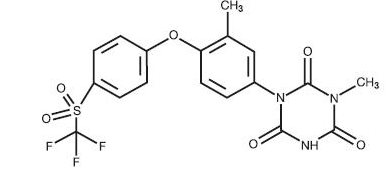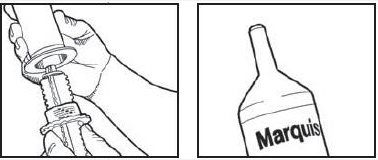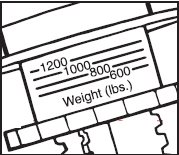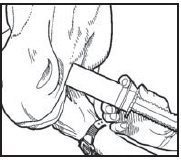MARQUIS ANTIPROTOZOAL- ponazuril paste
Marquis Antiprotozoal by
Drug Labeling and Warnings
Marquis Antiprotozoal by is a Animal medication manufactured, distributed, or labeled by Merial, Inc.. Drug facts, warnings, and ingredients follow.
Drug Details [pdf]
- SPL UNCLASSIFIED SECTION
-
DESCRIPTION
DESCRIPTION: MARQUIS® (15% w/w ponazuril) Antiprotozoal Oral Paste is supplied in a ready-to-use syringe containing 127 grams of paste. Each gram of paste contains 150 mg of ponazuril (15% w/w). MARQUIS is designed to be delivered as an orally administered paste.
Each syringe barrel of MARQUIS contains enough paste to treat one (1) 1,200 lb (544 kg) horse for seven (7) days, at a dose rate of 5 mg/kg (2.27 mg/lb) body weight or to treat one 1,200 lb (544 kg) horse with a single loading dose of 15 mg/kg (6.81 mg/lb) body weight and for four days subsequently at a rate of 5 mg/kg (2.27 mg/lb) body weight. The plunger contains a dosage ring calibrated for a dose rate of 5 mg/kg (2.27 mg/lb) body weight and marked for horse weight from 600 to 1,200 lbs (272 to 544 kg). The syringe barrel is packaged with a reusable plunger. The syringe barrels are packaged in units of four with four reusable plungers and in single syringe units with one reusable plunger.
Ponazuril is an anticoccidial (antiprotozoal) compound with activity against several genera of the phylum Apicomplexa.
- SPL UNCLASSIFIED SECTION
-
CLINICAL PHARMACOLOGY
CLINICAL PHARMACOLOGY: The activity of ponazuril has been demonstrated in several Apicomplexans1-6. Lindsay, Dubey and Kennedy7 showed that the concentration of ponazuril necessary to kill Sarcocystis neurona in vitro was 0.1 to 1.0 μg/mL. Furr and Kennedy8 evaluated the pharmacokinetics of ponazuril in serum and CSF in normal horses treated daily at 5 mg/kg for 28 days. The time to peak serum concentration (Tmax) was 18.20 (±5.9) days and the maximum serum concentration (Cmax) was 5.59 (±0.92) μg/mL. The terminal elimination half-life for serum (calculated using Day 28 to 42 data) was 4.50 (±0.57) days. In CSF, Tmax was 15.40 (±7.9) days and Cmax was 0.21 (±0.072) μg/mL.
A pharmacokinetic study was conducted in eight horses to collect serum and cerebrospinal fluid (CSF) levels of ponazuril after a single dose of 5 mg/kg body weight. The estimated parameter values were used to model time concentration profiles for ponazuril in serum and CSF. The model results were used to estimate the size of the loading dose needed to support the achievement of steady state serum and CSF levels after the first dose. The appropriate loading dose, calculated on the basis of the accumulation ratio (i.e., the fold increase in serum drug concentrations once steady state conditions have been achieved) was 15 mg/kg (6.81 mg/lb) body weight. This dose represents the range of estimated accumulation ratios of 2.3 to 3.3. Thus, a three-fold loading dose (3*5 mg/kg) was selected, leading to achievement of steady state blood levels in horses after one or two days of ponazuril administration.
- VETERINARY INDICATIONS
-
SPL UNCLASSIFIED SECTION
EFFECTIVENESS SUMMARY: A field study was conducted at six sites with seven investigators across the United States.9 The study was conducted using historical controls. In this study, each animal's response to treatment was compared to its pre-treatment values. The following standardized neurologic scale was used to grade the horses:
- Normal, no deficit detected
- Deficit just detected at normal gait
- Deficit easily detected and is exaggerated by backing, turning, swaying, loin pressure or neck extension
- Deficit very prominent on walking, turning, loin pressure or neck extension
- Stumbling, tripping and falling down spontaneously
- Recumbent, unable to rise
Improvement was defined as a decrease of at least one grade.
Naturally-occurring clinical cases of EPM, characterized by signalment and laboratory diagnosis, were randomly allotted to one of two treatment doses (5 or 10 mg/kg/day for a period of 28 days), then evaluated for clinical changes through 118 days. Acceptance into the study was based on the results from a standardized neurological examination including radiography, serum S. neurona IgG level determination by Western Blot (WB), and a positive cerebrospinal fluid (CSF) for S. neurona IgG level by WB.
Response to treatment was determined by the investigator to be acceptable when a clinical improvement of at least one grade occurred by no later than 3 months after treatment, regardless of whether the CSF by WB was positive or negative.
Changes in clinical condition were evaluated first by the subjective scoring of the investigator, then by masked assessment of videotapes of the neurological examination. At 5 mg/kg for 28 days, 28 of 47 horses (60%) improved at least one grade by Day 118. Seventy-five percent (75%) of those improved, that had also been videotaped, were corroborated successes by videotape assessment. At 10 mg/kg, 32 of 55 animals (58%) improved at least one grade by Day 118 and 56% of those improved, that had also been videotaped, were corroborated successes using videotape assessment. With respect to the clinical investigators' scores there was no statistical difference between 5 mg/kg and 10 mg/kg treatment group results (p = 0.8867).
- WARNINGS
-
PRECAUTIONS
PRECAUTIONS: Prior to treatment, EPM should be distinguished from other diseases that may cause ataxia in horses. Injuries or lameness may also complicate the evaluation of an animal with EPM. In most instances, ataxia due to EPM is asymmetrical and affects the hind limbs.
Neurologic deficits, primarily ataxia, have been reported to acutely worsen during the early treatment period. In some horses the worsening of the neurologic deficits was transient. (See Post Approval Experience Section).
Clinicians should recognize that clearance of the parasite by ponazuril may not completely resolve the clinical signs attributed to the natural progression of the disease. The prognosis for animals treated for EPM may be dependent upon the severity of disease and the duration of the infection prior to treatment.
The safe use of MARQUIS in horses used for breeding purposes, during pregnancy, or in lactating mares, has not been evaluated. The safety of MARQUIS with concomitant therapies in horses has not been evaluated.
-
ADVERSE REACTIONS
ADVERSE REACTIONS: In the field study, eight animals were noted to have unusual daily observations. Two horses exhibited blisters on the nose and mouth at some point in the field study, three animals showed a skin rash or hives for up to 18 days, one animal had loose stools throughout the treatment period, one had a mild colic on one day and one animal had a seizure while on medication. The association of these reactions to treatment was not established.
Post Approval Experience (2015)
The following adverse events in horses are based on post-approval adverse drug experience reporting. Not all adverse events are reported to FDA/CVM. It is not always possible to reliably estimate the adverse event frequency or establish a causal relationship to product exposure using these data. The following adverse events have been reported:
Neurologic deficits, primarily ataxia, have been reported to acutely worsen during the early treatment period. Although outcome was not always reported, in some horses the worsening of the neurologic deficits was transient.
To report suspected adverse drug events, for technical assistance or to obtain a copy of the Material Safety Data Sheet (MSDS) , contact Merial at 1-888-637-4251.
For additional information about adverse drug experience reporting for animal drugs, contact FDA at 1-888-FDA-VETS or online at http://www.fda.gov/AnimalVeterinary/SafetyHealth/ProductSafetyInformation.
-
SPL UNCLASSIFIED SECTION
ANIMAL SAFETY SUMMARY: MARQUIS was administered to 24 adult horses (12 males and 12 females) in a target animal safety study. Three groups of 8 horses each received 0, 10, or 30 mg/kg (water as control, 2X and 6X for a 5 mg/kg [2.27 mg/lb] dose). Horses were dosed after feeding. One half of each group was treated for 28 days and the other half for 56 days followed by necropsy upon termination of treatment. There were several instances of loose feces in all animals in the study irrespective of treatment, sporadic inappetence and one horse at 10 mg/kg (2X) lost weight while on test. Loose feces were treatment related. Histopathological findings included moderate edema in the uterine epithelium of three of the four females in the 6X group (two treated for 28 days and one for 56 days).
-
DOSAGE & ADMINISTRATION
DOSAGE: Administer MARQUIS at a dose of 15 mg/kg (6.81 mg/lb) body weight as a loading dose for the first dose only. The loading dose is followed by a maintenance dose of 5 mg/kg (2.27 mg/lb) body weight once daily for a period of 27 additional days.
Day 1: Administer a loading dose of 15 mg/kg (three times the maintenance dose) once by mouth. Because the dosage ring is calibrated by weight for the maintenance dose (5mg/kg), adjust the dosage ring to the appropriate weight and administer this 5 mg/kg dose orally, three consecutive times for a total dose of 15 mg/kg.
Day 2 through 28: Administer the maintenance dose of 5 mg/kg once daily by mouth.
-
DOSAGE & ADMINISTRATION
ADMINISTRATION:
- STORAGE AND HANDLING
- HOW SUPPLIED
- SPL UNCLASSIFIED SECTION
-
REFERENCES
REFERENCES:
- Mehlhorn, H., Ortmann-Falkenstein, G., Haberkorn, A.: (1984) The effects of the sym. Trianzinons on developmental stages of Eimeria tenella, E. maxima and E. acervulina: a light and electron microscopical study. Zeitschr Parsitenk 70: 173-182.
- Bohrmann, R.: (1991) Treatment with toltrazuril in a natural outbreak of coccidiosis in calves. Dtsch. Tierarzl. Wschr. 98: 343-345.
- Stafford, K.J., West, D.M., Vermunt, J.J., Pomroy, W., Adlington, B.A., Calder, S.M.: (1994) The effect of repeated doses of toltrazuril on coccidial oocyst output and weight gain in infected lambs. NZ Vet J 42(3): 117-119.
- Haberkorn, A.G., Stoltefuss, D.I.J.: (1987) Studies on the activity spectrum of toltrazuril, a new anti-coccidial compound. Vet. Med. Review 1: 22-32.
- Koudela, B., Vodstricilova, M., Klimes, B., Vladik, P., Vitovec, J.: (1991) Application of the anticoccidiosis drug Toltrazuril in the coccidiosis of neonatal pigs. Veterinami medicina (Praha) 36: 657-663.
- Benoit, E., Buronfosse, T., Delatour, P.: (1994) Effect of Cytochrome P-450 1A induction on enantioselective metabolism and pharmacokinetics of an aryltrifluoromethyl sulfide in the rat. Chirality 6(5): 372-377.
- Lindsay, D.S., Dubey, J.P., Kennedy, T.J.: (2000) Determination of the activity of ponazuril against Sarcocystis neurona in cell cultures. Vet Parasit 92: 165-169.
- Furr, M., Kennedy, T.: Pharmacokinetics of ponazuril in horses. Study 150-717 Bayer Corporation.
- Furr, M., Andrews, F., MacKay, R., Reed, S., Bernard, W., Bain, F., Byars, D., Kennedy, T.: Treatment of equine protozoal myeloencephalitis (EPM) with various doses of ponazuril. Study Report 150-664 Bayer Corporation.
- PRINCIPAL DISPLAY PANEL - 127 g Syringe Applicator Carton
-
INGREDIENTS AND APPEARANCE
MARQUIS ANTIPROTOZOAL
ponazuril pasteProduct Information Product Type PRESCRIPTION ANIMAL DRUG Item Code (Source) NDC: 50604-7314 Route of Administration ORAL Active Ingredient/Active Moiety Ingredient Name Basis of Strength Strength ponazuril (UNII: JPW84AS66U) (ponazuril - UNII:JPW84AS66U) ponazuril 150 mg in 1 g Packaging # Item Code Package Description Marketing Start Date Marketing End Date 1 NDC: 50604-7314-1 4 in 1 CARTON 1 127 g in 1 TUBE 2 NDC: 50604-7314-2 1 in 1 CARTON 2 127 g in 1 TUBE Marketing Information Marketing Category Application Number or Monograph Citation Marketing Start Date Marketing End Date NADA NADA141188 03/02/2015 Labeler - Merial, Inc. (799641006)
© 2025 FDA.report
This site is not affiliated with or endorsed by the FDA.







